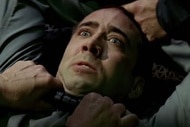Create a free profile to get unlimited access to exclusive videos, sweepstakes, and more!
Science Behind the Fiction: Exploring the real science behind Luther's big secret in The Umbrella Academy

In recent years, Netflix has cemented itself as a legitimate player in original content. The streaming service's latest endeavor, The Umbrella Academy — based on the Dark Horse Comics series of the same name by Gerard Way and Gabriel Bá — tells the tale of a family of estranged super-powered siblings brought back together by the death of their adoptive father, eccentric billionaire Sir Reginald Hargreeves.
**Spoilers ahead for The Umbrella Academy.**
Each of the adopted Hargreeves children has a unique power, which include the ability to speak to the dead, summon interdimensional tentacles, influence the minds of others, and travel through time, to name a few. Given code numbers in lieu of names, the Umbrella Academy children endure a childhood of strict adherence to a brilliant but unloving father hellbent on training up a team of special individuals to protect the world. Think the Avengers or the X-Men, but instead of Nick Fury or Professor X you have a stoic drill sergeant who cares only for results. Oh, and there's a sapient chimpanzee named Pogo.
Of the seven children, we're going to focus on one. Namely, we're going to focus on No. 1, aka Spaceboy, aka Luther, Hargreeves' personal favorite and the one whose abilities most closely match anything we'd be able to replicate in real life. His ability, enhanced strength, is mundane when juxtaposed against his siblings' abilities, but his leadership ability and loyalty make him an asset Hargreeves is eager to exploit. And his additional assets definitely make for some interesting questions.
In the Netflix series, Luther's unusually robust physical frame is something of a mystery, but in the source material, its cause is right out in the open. As a child, Luther embarked on a mission to Mars that ended in disaster and life-threatening injuries. In an effort to save his life, Hargreeves completed an experimental surgery, transplanting Luther's head onto the body of a Martian gorilla. In the Netflix series, when Luther is mortally wounded, Hargreeves injects him with a serum that seems to change his genetic makeup, giving him the body of an ape and the head of a man.
Suffice it to say, in both the comic and the Netflix series, his incredible strength isn't hindered by the procedure.
While much of the material in The Umbrella Academy is far fetched and fantastical, this particular story element tickles at the threads of reality. While science cannot (yet) give us time travel, teleportation, or the ability to contact the dead, we just might be able to make our own Spaceboy in the near future.
A BRIEF HISTORY OF XENOTRANSPLANTATION
Research into cross-species organ transplantation has been underway since as early as 1905. These early procedures were largely failures, enjoying only moderate, rare, and temporary successes, owing to a lack of knowledge surrounding the rejection process.
Still, interest in xenotransplantation remained as the supply of readily available human organs for transplantation was grossly insufficient. The prospect of xenotransplantation offers a seemingly unlimited supply of ready organs without the need to wait for a willing donor's death. Though, this practice would come with its own host of ethical questions in need of answering.
In the 1960s, Keith Reemtsma of Tulane University set to work tackling the problem of kidney failure in humans. At the time, chronic dialysis was not a ready treatment and the availability of kidney donors was low. Faced with patients in imminent need of organs, he offered a choice: palliative treatment or organ replacement. If the patients chose transplantation, they would be given a human kidney if one became available; otherwise, they would receive a replacement from a chimpanzee. No one tell Pogo.
In total, Reemtsma transplanted chimpanzee kidneys into 13 human patients. Most of the patients died within eight weeks, but one patient lived for nine months and, upon their death, an autopsy revealed that the donor organs were healthy.
In 1984, an infant known as Baby Fae was born with hypoplastic left heart syndrome, a fatal heart defect. She was otherwise in good health and it was believed that a transplant of the heart would result in her recovery. Without one, she would certainly die. Owing to the lack of available infant organs for transplantation, Baby Fae's parents were faced with the choice of awaiting her imminent death or undergoing an experimental surgery. They chose the latter. As a result, Dr. Leonard Bailey replaced Baby Fae's heart with that of a baboon. She lived for 21 days before succumbing to rejection.
While the procedure was unsuccessful for Baby Fae, it was the first partially successful infant heart transplant and brought to light the problem of organ shortages for children, resulting in an increase in donors shortly thereafter. Dr. Bailey also went on to complete the first human-to-human infant heart transplant a year later.
NOW AND IN THE FUTURE
While historically the search for the perfect cross-species transplant donors has focused almost entirely on non-human primates, that's changed. It's true that non-human apes such as chimpanzees have a high potential for successful xenotransplantation, but there are specific risks and ethical concerns to consider.
Firstly, their genetic similarity to humans is both a blessing and a curse. While animals such as chimpanzees might make good organ donors, they also carry with them the risk of transmitting infectious diseases. And medical concerns aside, there are ethical questions to consider, including the endangered nature of the species. Additionally, their closeness to humans and unique intelligence affords them a special place within the animal kingdom that many believe places them firmly outside the use of medical experimentation.
At current, the animal being most closely considered for xenotransplantation research is the pig. While pigs also display a high level of intelligence, they don't enjoy the privileged position of our primate cousins.
Since pigs are already being bred in massive numbers, the supply of organs is readily available. In addition, their genetic distance to humans reduces the likelihood of infectious disease crossover while their close proximity to humans over many generations suggests a certain level of safety. Pigs also have organs of roughly the same size as human beings and genetic modification has allowed for advances in the modifications, which would reduce the risk of rejection.
It is unlikely, at least in the foreseeable future, that we'll see the transplantation of non-human primate tissues into humans. But we may very well see the merging of humans with pigs. At the time of publication, George Orwell was unavailable for comment.
The Umbrella Academy is now available on Netflix.














